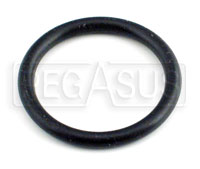When faced with different types of rubber seals, which do you choose? If there is only one type of O-ring available, is it the right choice? Sadly, one size does not fit all. Each rubber type has is strengths and weaknesses which dictate where a seal can or can't be used. |
Meet the Players
For the purposes of this article, we will focus on just three common rubber types found in O-rings and similar automotive seals: Buna N, Viton, and EPDM.
Note that each type is actually a family of rubber compounds. The term "Buna N" is really not much more specific than the term "steel". Just as there are many different alloys of steel with different physical properties, the chemistry of each of these rubber types can be tweaked to enhance resistance to a certain chemical, or for more desirable physical properties.
That means that we must deal in broad generalizations here. You may come across a specific manufacturer whose recommendations differ. That is because a manufacturer may specify a certain rubber formulation whose properties are somewhat different than what is typical for that type of rubber. The good news is that static applications (such as an O-ring between a threaded fitting and a female-threaded port) are more tolerant of material choice than dynamic applications (such as crankshaft seals or master cylinder seals). This article focuses on static seals only.
Buna N / NBR / Nitrile
Buna N (sometimes shortened to just "Buna") is a trade name for nitrile rubber, known internationally as NBR. It is normally the least expensive of the rubber types we will discuss here. NBR is compatible with petroleum fluids (including dinosaur and synthetic lubricating oils, pure gasoline, and diesel fuel). This makes it a good choice for seals in fuel systems running pure gasoline (no ethanol blends) or diesel (not biodiesel). NBR is also fully compatible with water and ethylene glycol coolants. On the other hand, NBR has a relatively low maximum operating temperature at 212F (250F can be tolerated in fully static seals, but seal life will diminish). It is not a great choice for seals in transmission or differential oil systems when higher temperatures are expected. (Note that some NBR blends have good resistance to alcohol, or higher temperature ratings.)
Viton / FKM / FPM / Fluorosilicone
Viton is a trade name for a type of fluorocarbon rubber developed by DuPont specifically for the aerospace industry. The ASTM in the USA uses FKM as the generic term, but DIN/ISO in Europe and the rest of the world prefer FPM. It is often the most expensive of the three rubber types discussed here. FKM is compatible with petroleum fluids (including dino and synthetic lubricants, pure gasoline, and diesel). FKM is also fully compatible with water and ethylene glycol coolants. Most FKM grades are also a little better than NBR at handling biodiesel and ethanol-blended fuels, although FKM is still not the best choice for ethanol -- and it is a downright poor choice for nitromethane. Its high 400F operating temperature makes FKM a better choice for sealing engine, transmission, and differential oil systems.
EPDM
While NBR and FKM have similar chemical resistance, EPDM is completely different. It is incompatible with petroleum (oil and gasoline), but it is compatible with alcohols (ethanol, methanol, and nitromethane), water, coolants (both ethylene and propylene glycol), and glycol-based brake fluid. Of all three rubber types, EPDM is the only one that should be considered for use anywhere in a braking system. (Of course there have to be exceptions -- the Citroen and Rolls-Royce high-pressure brake/suspension systems that use green hydraulic oil must avoid EPDM and should use FKM instead.)
Location, Location, Location
So, what is the best choice where?
Brake system
Of these three rubber types, EPDM is the only choice for seals in braking systems using a glycol-based or silicone-based DOT-approved or pure racing brake fluid. (If you buy your brake fluid from Pegasus Auto Racing Supplies, use EPDM seals in that system.) Don't panic, most companies that make master cylinder and caliper seals only offer them in an EPDM version. If a seal is made for automotive brake systems and the material is not specified, you can safely assume it is EPDM. FKM is an appropriate seal material only for those few who find themselves undertaking the unique adventure of rebuilding a Citroen or Rolls-Royce with hydraulic oil instead of brake fluid.
Engine oil systems
Regardless of the type of lubricant, FKM is the preferred seal choice for dynamic seals (sliding or rotating, such as crankshaft seals). NBR is acceptable for static seals such as O-rings between threaded fittings.
Transmissions and differentials
Manual or automatic, transmission or transaxle, go with FKM. Low-temperature applications (such as street cars) may be able to use NBR for static seals.
Fuel systems
If you are running pure gasoline or petroleum diesel in a non-return fuel system, NBR seals will be perfectly acceptable. But change the fuel to an ethanol blend or biodiesel and you should be looking at FKM. If you have a recircualting system (i.e., return line to the fuel tank), FKM seals will generally be more resistant to the oxidized fuel. Nitromethane systems require EPDM.
Cooling systems
All three rubber types are compatible with water and ethylene glycol coolant. All three will handle 212F and are acceptable to 250F in static applications. If you are running propylene glycol coolant, then EPDM is the best choice.
High-Performance Plumbing - Major Product Category
Plumbing Adapter Fittings
Sealing Washers and O-Rings
Further Reading About Plumbing Systems


